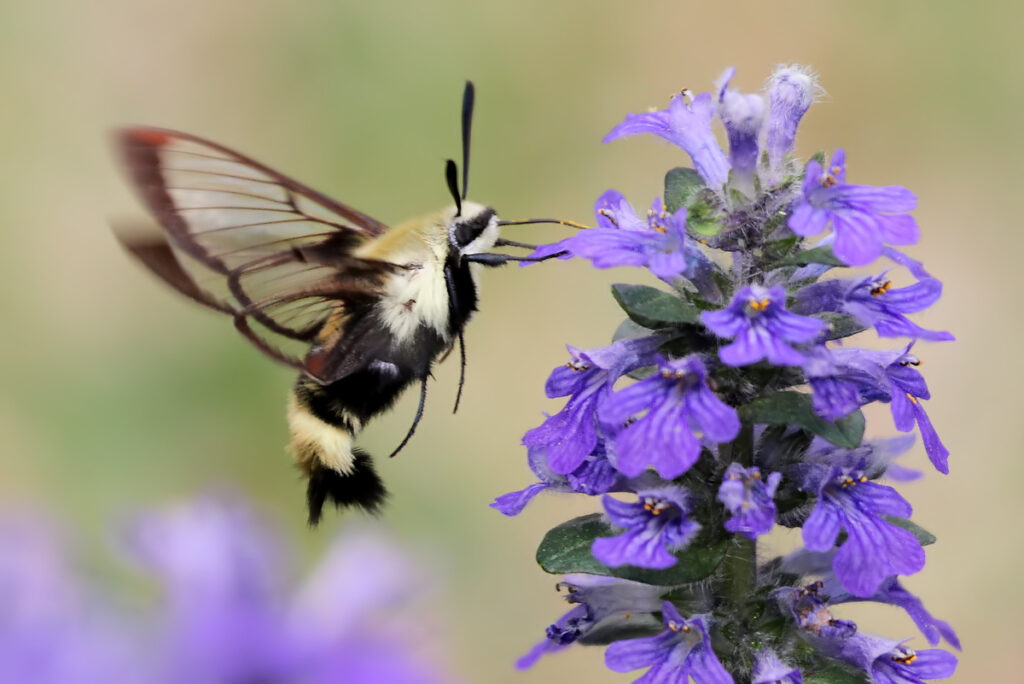As I was walking at McVey Memorial Forest, I heard a humming sound and a small bird zooming around some purple wildflowers.
Upon a closer look, the bird’s body did not look quite right. It was fuzzy and I could see right through its wings! As it turns out, it wasn’t a bird at all, but a clearwing hummingbird moth. The natural world is filled with fascinating creatures, each playing unique roles in the ecosystem. Among these, hummingbird moths stand out as some of the most intriguing and often misidentified pollinators.
Hummingbird moths are medium-sized moths with wingspans ranging from 1.5 to 2 inches. Their bodies are robust and furry, with coloration that often mimics that of hummingbirds, ranging from green and gold to brown and white. This mimicry extends to their rapid wing movements, which produce a humming sound similar to that of hummingbirds. Unlike most moths, hummingbird moths are diurnal, meaning they are active during the day.
The most common species in North America include the Hummingbird Clearwing and the Snowberry Clearwing. These moths are easily recognized by their transparent wings with dark borders. Their long proboscis, which can be nearly twice the length of their body, is perfectly adapted for sipping nectar from deep-throated flowers.
Hummingbird moths are widespread across North America. They are typically found in gardens, meadows, and open fields where flowering plants are abundant. Their flight pattern is erratic and swift, often mistaken for that of a small bird. Unlike most moths that rest with wings folded, hummingbird moths perch with their wings spread, further enhancing their bird-like illusion.
These moths are known for their exceptional flying abilities. They can hover in mid-air, fly backward, and change direction swiftly, allowing them to access nectar from a variety of flowers. They are particularly attracted to brightly colored, tubular flowers. The ability to hover enables them to feed on nectar while staying airborne, much like hummingbirds.
The life cycle of hummingbird moths begins with eggs laid on the leaves of host plants, such as hawthorn and viburnum. Upon hatching, the larvae, often referred to as hornworms, feed voraciously on the foliage. These caterpillars have distinctive horn-like tails and can grow large before pupating. The adult moths emerge after several weeks, ready to begin the cycle anew. This life cycle, from egg to adult, typically spans several months, allowing for multiple generations in a single year, especially in warmer climates.
While hummingbird moths are not currently considered endangered, their populations, like many pollinators, face threats from habitat loss, pesticide use, and climate change. Urbanization and agricultural practices can reduce the availability of nectar-rich flowers and host plants necessary for their survival. Pesticides, in particular, can be detrimental, affecting both adult moths and their larvae.
Conservation efforts aimed at protecting hummingbird moths focus on creating and maintaining pollinator-friendly habitats. This includes planting a diversity of native flowering plants, reducing pesticide use, and preserving natural areas. Gardeners can contribute by cultivating plants that provide nectar and larval food sources, ensuring that these remarkable moths continue to thrive. Red-tail Land Conservancy’s Growing Home™ backyard habitat certification program aims to educate and empower people to garden for wildlife. Details on the program can be found at www.ForTheLand.org/GrowingHome.
Hummingbird moths are extraordinary pollinators whose behaviors and adaptations make them a vital part of the ecosystem. Their striking resemblance to hummingbirds, coupled with their unique flying abilities, captures the fascination of anyone lucky enough to observe them.
Photo: Clearwing Hummingbird Moth. Credit: Ken Slade
Kelley V. Phillips is the Assistant Director for Red-tail Land Conservancy. She strives to cultivate wonder in nature and action to protect it.




